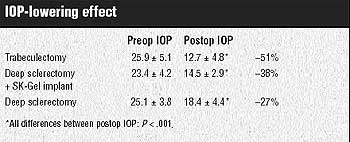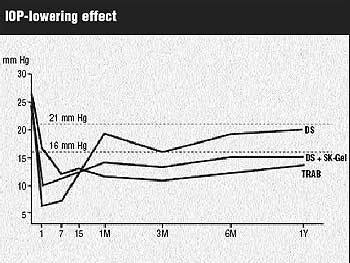Deep sclerectomy, trabeculectomy in POAG effective, study shows
The importance of hyaluronic acid implants also was confirmed.
UDINE, Italy – Deep sclerectomy with the SK-Gel implant is effective, according to a multicenter study.
|
The study compared the results of trabeculectomy and deep sclerectomy with and without the hyaluronic acid implant (Cornéal). A total of 48 patients with primary open-angle glaucoma participated in the study. They were all in the middle stage of the disease, with intraocular pressure 30 mm Hg or less while being treated and an evident but not advanced perimetric defect.
The study was conducted at the Verona University Eye Clinic and Udine and Conegliano Eye Clinics by Giorgio Marchini, MD, Paolo Brusini, MD, and Giovanni Prosdocimo, MD.
Results were presented here at the meeting Surgical Treatment of Primary Open-Angle Glaucoma – Present and Future.
“Indications for surgery were IOP uncontrolled by medical therapy and loss of visual function. Selected patients were randomly assigned to one of the three treatment options, and only one eye for each patient was included in the study,” Dr. Brusini said.
“Patients were seen at short intervals in the first postoperative period, then at 3 and 6 months. We evaluated the IOP-lowering effect, complication rate and visual function. Our present follow-up is 1 year,” he added.
IOP lowering
The diagram on the facing page shows the IOP curves in the follow-up.
“Trabeculectomy and deep sclerectomy with SK-Gel implant show a similar efficacy, at the limit of statistically significant difference. From month 1, trabeculectomy is 2 mm Hg on average below deep sclerectomy. In patients who had deep sclerectomy without SK-Gel implant, the IOP-lowering effect of the treatment was good in the first 15 to 30 days, but after that time, IOP set between 16 and 21 mm Hg,” Prof. Marchini reported.
Mean values of IOP calculated after 1 year were 12.7 mm Hg in the trabeculectomy group, 14.5 mm Hg in the deep sclerectomy group with SK-Gel implant and 18.4 mm Hg in the deep sclerectomy group without implant.
“We had a reduction of 51% from preoperative IOP in the trabeculectomy group, of 38% in the deep sclerectomy group with SK-Gel implant and of 27% in the group without the implant. The difference between preoperative and postoperative IOP values was statistically significant in all groups, which means that deep sclerectomy IOP-lowering effects are quite similar to those of trabeculectomy, but the implant decisively improves the results of this surgery,” Prof. Marchini said.
As target pressure lowers
“However, if we analyze the success rate at different IOP levels, the gap between deep sclerectomy and trabeculectomy increases as the target pressure lowers,” Prof. Marchini said.
“While both trabeculectomy and deep sclerectomy with SK-Gel implant show a good compensation of IOP below 21 mm Hg, when the target is set at 18 mm Hg, there is a small difference between the two in favor of trabeculectomy. The gap becomes much larger if the target is 16 mm Hg,” he said.
Results showed that IOP below 21 mm Hg was achieved by 100% of patients in both groups, while with IOP lower than 18 mm Hg, the percentage was 87% in the trabeculectomy group and 80% in the deep sclerectomy group with implant. With IOP lower than 16 mm Hg, it was 74% versus 67%.
“The group of deep sclerectomy without implant had disappointing results at all IOP levels. Only 74% of patients had IOP lower than 21 mm Hg, and values dropped to 54% and 34% when target was 18 mm Hg and 16 mm Hg, respectively,” Prof. Marchini said.
Complications
As confirmed by other studies, trabeculectomy had the highest rate of complications. Complications mostly occur during the first week after surgery and are more frequent and more serious than in deep sclerectomy, Prof. Marchini reported.
“We had one case of shallow anterior chamber, two cases of hyphema and three cases of choroidal detachment in the trabeculectomy group. There were three mild cases of Seidel, which only lasted a day, in the group of deep sclerectomy with implant and one case of circumscribed choroidal detachment in the group without the implant. Signs of inflammation of the anterior chamber were rare in both deep sclerectomy groups, but were detected in about one-third of trabeculectomy patients,” he said.
A flexible approach
“In conclusion, we can say that deep sclerectomy with SK-Gel implant has good functional results, fewer complications but a slightly lower rate of success than trabeculectomy in lowering intraocular pressure,” Dr. Prosdocimo said.
“On the other hand, since we don’t cure glaucoma, but a patient suffering from glaucoma, we should decide case by case which is the best treatment to propose. Since there are many variables to consider, flexibility and personalized treatment are necessary. It’s like playing golf: we don’t always use the same club,” he said.
He also said that in some cases, he is not at all against the use of medications after deep sclerectomy if they can help to maintain good results in the long term and achieve lower IOP values.
“After all, we have never compared the efficacy of trabeculectomy to deep sclerectomy with additional therapy, and this is not a fair competition, since lower IOP values in trabeculectomy are largely due to the use of antimetabolites,” he said.
Prof. Marchini also insisted on flexibility and variables.
“Although we prefer deep sclerectomy whenever possible, trabeculectomy may still be the best choice in patients who need to achieve a low target pressure or in complicated cases at an advanced stage of the disease. Deep sclerectomy is probably better indicated at less advanced stages of the disease and in patients with a shorter life expectancy,” he said.
Dr. Brusini also noted that expert surgeons are needed to carry out deep sclerectomy safely and effectively.
“It is a difficult technique, with a long learning curve. The more surgeons gain experience with it, the better the results will be and the greater the number of cases able to be treated,” he said.
For Your Information:
- Giorgio Marchini, MD, can be reached at Clinica Oculistica, Università di Verona, Ospedale Borgo Trento, P.le Stefani 1, 37126 Verona, Italy; (39) 045-807-2340; fax: (39) 045-807-2025; e-mail: oculist@borgotrento.univr.it. Dr. Marchini has no direct financial interest in any of the products mentioned in this article, nor is he a paid consultant for any companies mentioned.
- Paolo Brusini, MD, can be reached at U.O. di Oculistica, Azienda Ospedaliera S. Maria della Misericordia, 33100 Udine, Italy; (39) 043-255-2743; fax: (39) 043-255-2741; e-mail: brusini@libero.it. Dr. Brusini has no direct financial interest in any of the products mentioned in this article, nor is he a paid consultant for any companies mentioned.
- Giovanni Prosdocimo, MD, can be reached at U.O. di Oculistica, Ospedale Civile, 31015 Conegliano (TV), Italy; (39) 043-865-8342; fax: (39) 043-865-8330; e-mail: gprosdocimo@ulss7pieve-veneto.it. Dr. Prosdocimo has no direct financial interest in any of the products mentioned in this article, nor is he a paid consultant for any companies mentioned.
- Cornéal can be reached at 31, Rue des Colonnes, 75012 Paris, France; (33) 1-43-42-9393; fax: (33) 1-43-07-0190; e-mail: export@corneal.com.




